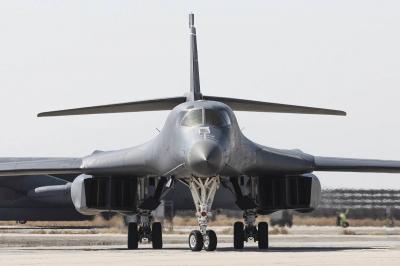A U.S. defense official revealed to CNN that the B-1 bomber was involved in the strikes executed by U.S. forces on targets in Syria and Iraq on Friday. The network reported that U.S. officials waited for favorable weather conditions to conduct the strikes to avoid civilian casualties. This bomber can carry both long-range, unguided munitions and precision-guided munitions.
Douglas Sims, the director of operations at the U.S. Joint Chiefs of Staff, stated to reporters that the bomber crews took off from the United States and successfully completed the mission without stopping. He added that the U.S. is "really confident" in the accuracy of its strikes on the targets, attributing this to the "B-1 bombers." Sims confirmed that the preliminary assessment indicates that all targeted objectives were hit, with reports of "secondary explosions related to munitions and logistics sites" that were attacked by the U.S.
He noted that "we know armed individuals use these sites" and that the strikes were carried out with the understanding that "there were likely individuals inside these facilities," indicating that care was taken to avoid causing "unnecessary injuries or fatalities." The U.S. military official indicated that Friday was chosen for the strikes as it represented the "best opportunity" in terms of weather, noting that while U.S. munitions can operate under any conditions, good weather was selected to ensure that "we hit all the right targets."
For its part, U.S. Central Command (CENTCOM) disclosed details about the air raids on Iraq and Syria, which targeted Iranian Revolutionary Guard Corps and sites linked to its Quds Force. The U.S. military stated in a statement that the strikes targeted objectives including command and control centers, missile and drone storage facilities, as well as logistics and ammunition supply sites. The strikes targeted 85 sites across seven locations, four in Syria and three in Iraq, and involved the use of long-range B-1 bombers that launched from the United States.
The strikes aimed at the Quds Force, which is responsible for external operations and is the paramilitary wing of the Iranian Revolutionary Guard Corps, known for its strong influence over allied factions in the Middle East, including Lebanon, Iraq, Yemen, and Syria.
According to the U.S. Air Force, B-1 bombers have the largest conventional payload of guided and unguided weapons in the Air Force inventory and are the backbone of the U.S. long-range strike capability. They can quickly deliver large quantities of both precision and non-precision weapons against any adversary anywhere in the world, at any time.
Boeing noted that the B-1 is a conventional, long-range, multi-mission bomber capable of supersonic speed and has served the U.S. Air Force since 1985. Despite its introduction in the 1980s, it is expected to remain in operation at current operational tempos until 2040 and beyond, with Boeing working in conjunction with the U.S. Air Force to maintain it.
A report on the bomber by National Interest stated that the B-1 is "impressive" in terms of its capabilities, designed to operate in the air with a large weapons load, both internally and externally, capable of carrying anti-ship "JSOW" missiles and bombs. The bomber relies on four General Electric F101-GE-102 turbofan engines, each providing about 17,000 pounds of thrust.
According to Boeing, it is 44.5 meters long, 10.4 meters high, weighs 86,000 kilograms, and can carry a maximum weight of 216,000 kilograms. CENTCOM revealed that the airstrike targeting an Iranian Revolutionary Guard facility in eastern Syria on Wednesday involved a B-1 Lancer bomber, one of the oldest weapons in the U.S. arsenal, which has been in service since 1985.
Its fuel capacity is 120,000 pounds, and it can reach speeds of up to 1448 kilometers per hour, with a crew consisting of a pilot, co-pilot, and two weapons systems officers.
The attack in Jordan was the first incident resulting in U.S. casualties since the outbreak of the war between Israel and Hamas in October and marked a significant escalation in tensions. U.S. officials told Reuters that they assessed the drone that killed the three soldiers was Iranian-made. President Joe Biden stated in a statement: "Our response began today and will continue at times and places of our choosing." Earlier on Friday, Biden and Defense Department leaders attended a ceremony for the arrival of the remains of the three U.S. soldiers at Dover Air Force Base in Delaware.
Defense Secretary Lloyd Austin said that Biden had instructed further actions against the Iranian Revolutionary Guard and affiliated groups, stating, "This is the beginning of our response." However, the Department of Defense expressed that it does not want a war with Iran and does not believe that Tehran desires one, despite increasing pressure from Republicans on Biden for a direct strike on Iran.
Austin remarked, "We do not want conflict in the Middle East or anywhere else, but the president and I will not tolerate any attacks on U.S. forces." Roger Wicker, the top Republican on the Senate Armed Services Committee, criticized Biden for not sufficiently imposing losses on Iran and for delaying the response, according to Reuters. He added, "The Biden administration spent nearly a week making our intentions known to our adversaries foolishly, giving them time to move and hide."




